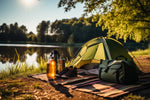Walter Hix
Emergency Signaling: How to Get Rescued When Stranded in the Wild
Imagine being stranded in the wilderness, miles away from civilization. Your survival depends not only on your ability to endure harsh conditions but also on your ability to signal for help effectively. This article will guide you through the essential techniques of emergency signaling, focusing on how to signal for SOS, use signaling flares, and sign for help when you find yourself in a survival situation.
Understanding the Importance of Emergency Signaling
Emergency signaling is a critical survival skill that can mean the difference between life and death when stranded in the wild. It involves using various methods to attract attention and communicate your distress to potential rescuers. These methods can range from simple hand signals and whistle blasts to more complex techniques involving flares and mirrors. The key is to make your signals visible or audible from a distance, increasing your chances of being spotted by rescuers.
How to Signal for SOS
The SOS signal is internationally recognized as a distress signal. It was originally used in Morse code, where it is represented as "...---...", but it can also be signaled visually or audibly.
To signal for SOS visually, you can use a flashlight or another light source at night, or a mirror during the day. The signal consists of three short flashes, three long flashes, and three short flashes again. If you're using a light source, turn it on and off to create the flashes. If you're using a mirror, angle it so that it reflects the sun's light and creates flashes.
To signal for SOS audibly, you can use a whistle, horn, or even your voice if necessary. The signal is three short blasts, three long blasts, and three short blasts again.
Remember, consistency is key. Repeat your SOS signal at regular intervals to increase your chances of being heard or seen.
Using Signaling Flares
Signaling flares are a highly effective way to signal for help, especially at night or in low-visibility conditions. They are designed to produce a bright, intense light or smoke that can be seen from a great distance.
To use a flare, first read the instructions carefully. Some flares require you to pull a string or pin, while others require you to strike them like a match. Once the flare is ignited, hold it above your head and away from your body. Be aware that flares can be hot and can drip burning material, so be careful not to burn yourself.
Flares are most effective when used in a clear area where they can be easily seen from the air or from a distance on the ground. They can also be used to signal for SOS by firing three flares in quick succession.
Other Ways to Sign for Help
In addition to signaling for SOS and using flares, there are several other ways to sign for help when stranded in the wild.
One method is to use ground-to-air signals. These are symbols created on the ground that can be seen from the air. The most recognized ground-to-air signal is the letter 'V', which stands for 'require assistance'.
Another method is to use signal fires. Three fires arranged in a straight line or a triangle is an internationally recognized distress signal.
You can also use brightly colored clothing or gear to create a signal. Lay out your items in an open area to create a contrast with the surrounding environment.
The Art of Smoke Signaling
Smoke signaling is an ancient form of communication that can be particularly effective during daylight hours. The key to successful smoke signaling is creating a smoke source that is thick and visible from a distance. This can be achieved by adding green leaves or branches to your fire, which produce more smoke when burned.
To send a distress signal using smoke, you need to create three separate sources of smoke. This is an internationally recognized signal for help. If possible, try to create your smoke signals on a hill or open area where they can be easily seen from the air.
However, be aware of your surroundings when using smoke signals. In dry conditions, a fire can quickly get out of control and cause a wildfire. Always ensure your fire is contained and fully extinguished after use.
Using Sound to Signal for Help
Sound can be an effective way to signal for help, especially in dense forests or foggy conditions where visibility may be limited. Whistles, gunshots, and even banging pots and pans together can create loud noises that can be heard from a distance.
Like visual signals, sound signals should be used in a series of three to indicate distress. For example, three whistle blasts or three gunshots can be used to signal for help. Remember to pause between each series of sounds to listen for a response.
Using Natural Materials for Signaling
In a survival situation, you may not have access to flares, mirrors, or other signaling devices. In such cases, you can use natural materials to create visible signals.
For example, you can use rocks, logs, or even footprints in the snow to create large SOS symbols or other distress signals. You can also use mud or charcoal to write messages on large, flat surfaces.
If you're near a beach or sandy area, you can use a stick to draw symbols or messages in the sand. You can also pile up rocks or create mounds in the sand to create visible signals.
Signaling at Night
Signaling for help at night can be challenging, but there are several techniques you can use. Flashlights, lanterns, or any other light source can be used to send light signals. You can flash your light source in the SOS pattern to send a distress signal.
Fire is also an effective signaling method at night. A large fire can be seen from a distance and can attract the attention of rescuers. If you have the resources, you can create three fires in a straight line or triangle to send a distress signal.
The Importance of Preparation
While knowing how to signal for help in a survival situation is important, the best strategy is to be prepared and avoid getting stranded in the first place. Always tell someone where you're going and when you expect to return before heading into the wilderness. Carry a map and compass and know how to use them. Pack a survival kit with essential items like a whistle, mirror, flares, and a flashlight.
Conclusion
Being stranded in the wild can be a terrifying experience, but with the right knowledge and skills, you can increase your chances of being rescued. Remember, the key to successful emergency signaling is visibility and audibility. Whether you're using a mirror to reflect sunlight, blowing a whistle in a specific pattern, or lighting a flare in the dead of night, your goal is to make your presence known and get rescued.
In the end, survival in the wild is as much about mental strength as it is about physical endurance. Stay positive, stay active, and stay hopeful. Your will to survive can be your most powerful tool when stranded in the wild. And with the right emergency signaling techniques, you can make sure that when help is on the horizon, they'll know exactly where to find you.
Photo by Павел Гавриков
Share on:










